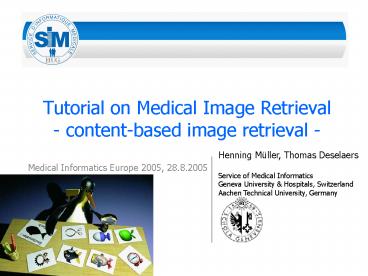Tutorial on Medical Image Retrieval contentbased image retrieval - PowerPoint PPT Presentation
1 / 16
Title:
Tutorial on Medical Image Retrieval contentbased image retrieval
Description:
Tutorial on Medical Image Retrieval - content-based image retrieval ... Journalist stock photography. Allows browsing in large archives ... – PowerPoint PPT presentation
Number of Views:121
Avg rating:3.0/5.0
Title: Tutorial on Medical Image Retrieval contentbased image retrieval
1
Tutorial on Medical Image Retrieval-
content-based image retrieval -
- Medical Informatics Europe 2005, 28.8.2005
Henning Müller, Thomas Deselaers Service of
Medical Informatics Geneva University
Hospitals, Switzerland Aachen Technical
University, Germany
2
Overview
- Goals
- Application domains
- System overview
- Some example systems
- The gaps and problems
- The achievements
- The medical domain
- Similarities
- Differences
3
Goals
- Improve the management of multimedia data
- Strongly rising in all fields
- Digital cameras at consumer prizes
- Allows search that is not really possible with
text - Feelings, impressions,
- Collaborative filtering
- Abstract forms of trademarks
- Permits to search where there is no text
available - Annotation is expensive and also subjective
4
Application domains
- Trademark retrieval
- In addition to text (Vienna code)
- Well for describing objects
- Abstract forms are extremely hard to describe
- Journalist stock photography
- Allows browsing in large archives
- Journalists often do not know what exactly to
look for - Sleep over decisions
- Decisions based on rough feeling
- Rough concept
- A few other domains
- CT retrieval, search of web images,
5
System overview
6
System variables
- Visual features
- Distance measures
- Learning methods
- From test datasets
- From user interaction
- Quality of the GUI (2D, 3D, number of clicks, )
- Speed of retrieval, and of indexing
- Interaction models
- Relevance feedback, pos., neg., numbers of images
- Image browsing (PicHunter)
7
QBIC Query by image content
- IBM, commercial product, 1993
- Add on for DB2
- Simple color, texture, layout features
- Very simple feedback
8
Blobworld, 1997
9
PicHunter
- Browsing tool for target image search
- Optimizes information gain from images being
presented to the user - Another system is filter image browsing
(Amsterdam)
10
ASSERT
11
The gaps and problems
- Sensory gap
- The information is lost by representation a real
world object by the means of a computer, cannot
really be shortened - Semantic gap
- Can be shortened when using higher level features
and learning - Page zero problem
- We are used to text, but not to visual features
to start a query - Evaluation
- No common datasets, no comparison, no prove of
performance - Real world use of systems
- Only very few systems, mainly academic world
12
Achievements
- Large number of visual features were developed
- Invariance models for color, size, rotation, etc.
were developed - Interaction models and relevance feedback were
explored - Probabilistic models for image similarity,
classification, - Salient region discovery
- Fast access to indexed features (DBs, Inverted
files, ) - Feature space reduction methods
- BUT Much was already there in text retrieval
13
The medical domain
- Differences
- Currently images are almost always accessed by
patient ID, only - Problems to use images for other tasks than
directly for healing the patient (laws) - Images are mainly in gray levels
- Saliency models might not work
- Color invariance models do not work
- BUT images often taken under standardized
conditions - Imaging modalities change and can produce very
different images - Advances in modalities can be quick
14
Problems with current systems in medicine
- Mostly, needs are defined by MDs
- Large number of publications
- Most systems are developed in computer science
departments without a direct medical connection - Only use of datasets for evaluation
- Sometimes the expectations are too high
- Set realistic goals
- Datasets are expensive to get and often protected
for privacy reasons - Real world use in clinical practice is inexistent
- Get user feedback
15
The medical domain
- Similarities
- Many of the texture and shape features will work
- General concepts and frameworks are the same
- Databases, access,
- Specializations need to be done but learning
works as well as for other specialized domains - Many of the problems that seem specific to the
medical field apply in other domains as well - Domain knowledge needs to be integrated
16
Conclusion
- Content-based retrieval can be an important
concept for multimedia data management - And the amount of data is rising quickly
- Many good research prototypes exist
- Systems need to be integrated with routine tools
to get real user feedback - In the medical fields, computer scientists and
MDs need to work together on system integration
and use































